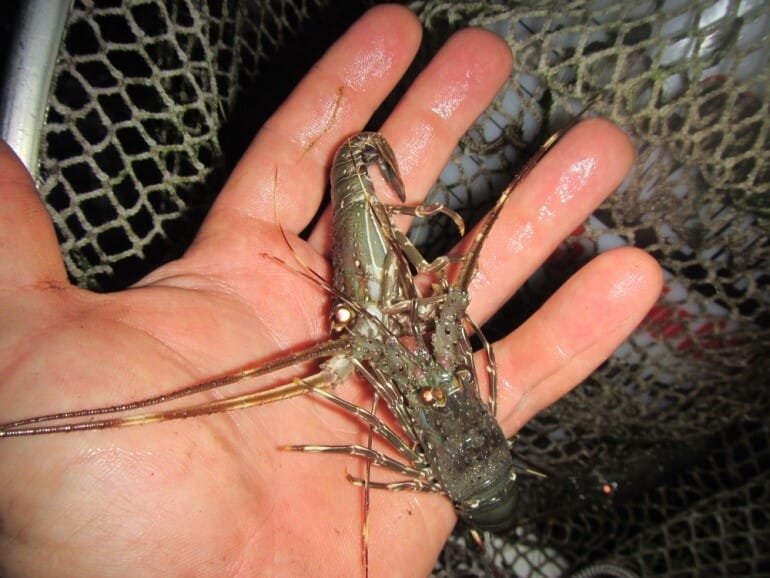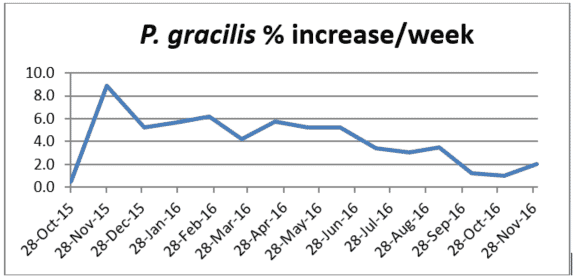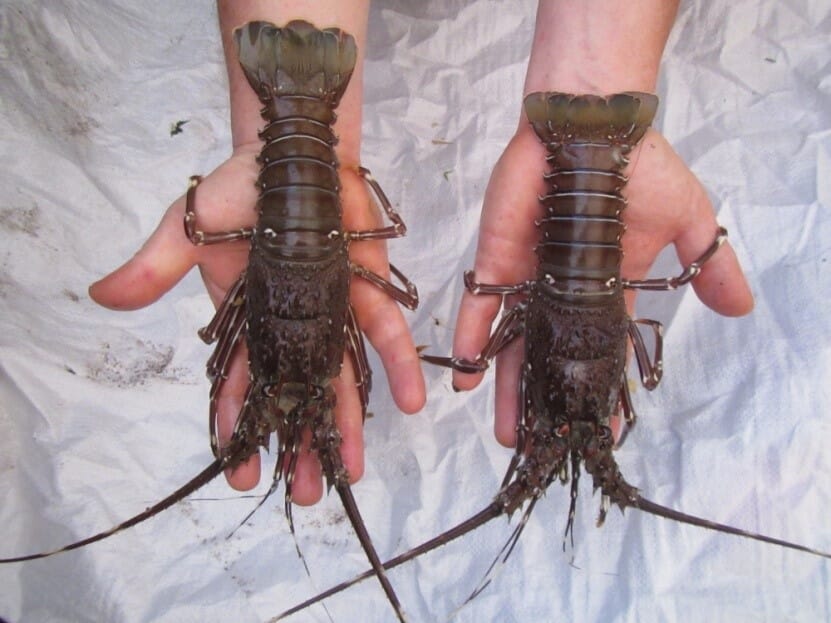The Pacific Spiny Lobster of Panama is in dire straits due to overfishing for many years without any regulation. Estimates of populations in the Bay of Chiriquí indicate numbers are dismally low and lobsters for sale are hard to find throughout the local province. Although catch statistics are unavailable, export data indicates that there is somewhere around 190 tons of lobsters harvested every year along the entire vast Pacific coastline of Panama. In contrast to this there is 10 times the harvest of an Atlantic species from the smaller area of Bocas del Toro on the Caribbean side of Panama.
Although there are spiny lobsters grown in nets in the estuaries on the coast of Vietnam purported to be worth $70 million, there have been reports of environmental degradation due to eutrophication due to this practice.
Outside of Asia, there are only a few small fledgling operations (P. argus) known in this hemisphere, confined to the Caribbean region. Thorough internet searches yield only anecdotal information available on the Pacific Spiny Lobster and indeed there are no formal reports available anywhere on the success or even the attempt to grow P. gracilis, and so the aquaculture of this species is likely nonexistent.
The overt challenges in spiny lobster aquaculture are many and this has prevented the start of this industry in this hemisphere. Perhaps the biggest hindrance to lobster production might be the exceptionally long larval cycle which is 3-6 months. More variables adding to the difficulty would be lack of a well designed feed pellet that is assimilated and produces acceptable FCRs (<3), the long time to harvest size (typically 2 years) and finally, the total lack of information on important culture requirements such as appropriate feed amounts, expected growth rates, water quality demands and substrate requirements. All totaled, these ill defined variables make the culture of P. gracilis seem a daunting task.
Other similar lobster species (P. argus) have been documented to have been experimentally grown in land based water exchange systems in the US at densities of 20-100/m3 at a biomass over 10kg/m3(?). However, few details regarding the many variables important to the success of spiny lobster culture could be found. Further to this, P. gracilis has never been grown in any system successfully and no lobster anywhere in the world has ever been grown in a zero water exchange aquaculture system, until now.
P. gracilis reaches 5 kg/m3 of biomass in a zero water exchange system in Panama
Juvenile P. gracilis were stocked in a zero water exchange system at 41/m3 at a size of 10 g during October, 2015. Lobsters were fed a variety of high protein feeds which yielded varying rates of growth and assimilation. Typical shrimp pellets of <35% protein were ignored and feed with a higher animal protein of a marine origin was necessary to produce growth. This species like most of the other spiny lobster species of the world, consumes only high protein feeds (>40%) which make up 60% or more of the variable costs for production.

Average 4-week growth rates were determined throughout the yearly growth trial by removing all lobsters from the system and weighing. During the course of the year growth varied from 1.4 to 8.8% increase per week with FCRs ranging from 2 to 18.3. Most importantly, the biomass of this lobster increased to over 5 kg/m3 with a final average growth rate of 2.0%/wk recorded on 7-December-16.
Survivals were 96% for the past 5 months of the one-year growth trial, and 76% survival overall with a trend of a more uniform size over the course of the cycle. In other words, size variability decreased with the mortality or increased growth of runts as the cycle progressed.
It has been determined that in general, P. gracilis does not tolerate any poor water quality and a single animal showed a bacterial infection when NO2 concentrations reached 2 mg/L for one week. This issue was quickly resolved with one of several, seldom used but reliable contingencies not requiring water exchange.
However, the following monthly sampling showed an additional 4 lobsters with bacterial infections on the shell which were linked to high solids content of culture water. Infections were typically found on the tail region and disappeared when lobsters molted and changes were made to reduce solids produced within the system.
A single mortality then occurred on 22-Nov-16 with an individual displaying a shell infection located between the carapace and tail.
The growth rates for two months during the high solids and measurable NO2 levels were 1.2 and 1.1%/wk which is less than half of the yearly average growth rate.
A change to the zero water exchange system to increase solids removal resulted in increased molting of lobsters as evidenced by the observation and removal of shells that were found floating typically in the early morning hours. There was a trend of synchronous molting with all molts for the whole month occurring during one week during the new moon. This is perhaps related to the "selfish herd hypothesis" as discussed in the available literature concerning shrimp.

There was a general trend noted during the study of decreased growth with increased biomass. Other important findings recorded were the trend for constant survival during the last half of the cycle. Of particular note was during the last two out of three months with the decreased growth rate associated with high solids and low level nitrite. However, mortality averaged 3% per 4wk sampling period for the first 7 months when solids were low.

Conclusion
For the first time ever, the Pacific Spiny Lobster (P. gracilis) has been grown successfully in a closed, land based aquaculture system in Panama, 600 m above sea level, 15 miles from the ocean at a biomass of over 5 kg/m3. Animals grew well at a high biomass with system adjustments to remove solids and control nitrite. It is possible that with these changes a much higher biomass can be achieved, resulting in the potential profitability of spiny lobster aquaculture.

Thanks goes to Zeigler Feeds of the US for providing some of the feeds for this experiment.
Sources:
POPULATION ASSESSMENT OF THE PACIFIC GREEN SPINY LOBSTER PANULIRUS GRACILIS IN PACIFIC PANAMA HECTOR M. GUZMAN,1* ROBERTO CIPRIANI,1,2 ANGEL J. VEGA,3 MELINA LOPEZ4 AND JAMES M. MAIR5
Smithsonian Tropical Research Institute, Apartado 0843-03092, Balboa, Ancon, Panama; Journal of Shellfish Research, Vol. 27, No. 4, 907–915, 2008.
http://myfwc.com/research/saltwater/crustaceans/lobster/facts/
https://www.pacseafood.com/products/details/seafood/spiny-lobster/
http://spo.nmfs.noaa.gov/mfr761-2/mfr761-23.pdf
https://researchspace.auckland.ac.nz/handle/2292/26185
All of the available information in scientific journals from science direct was downloaded and reviewed for this article, there were approximately 200 papers, most from work in Australia.




